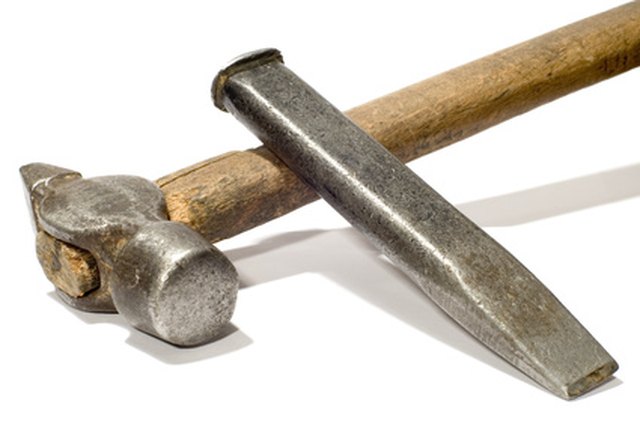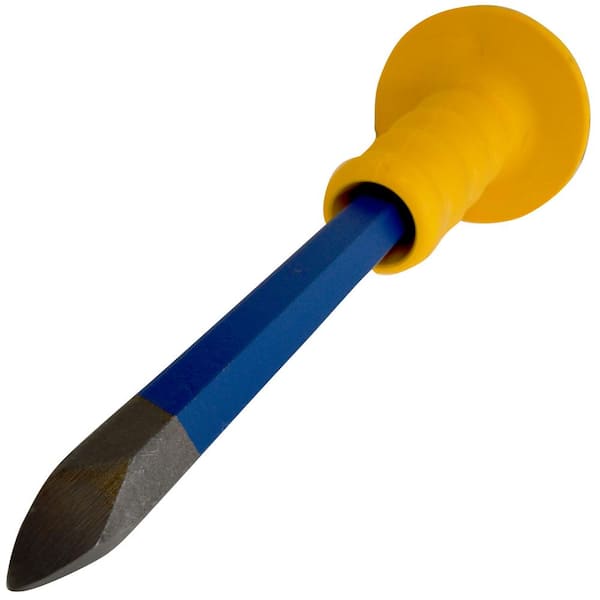Can you use a chisel on concrete? You might have wondered about this while working on a building project or doing some DIY repairs. Well, let’s dive in and find out if a chisel is a suitable tool for concrete!
Concrete is known for its strength and durability, making it a popular material in construction. But when it comes to shaping or removing concrete, you need specialized tools. So, can a chisel do the trick?
In this article, we’ll explore whether using a chisel on concrete is a feasible option. We’ll discuss the limitations, alternatives, and provide you with all the information you need to make an informed decision. Let’s get started!
Using a chisel on concrete can be challenging, but it is possible with the right technique. Here’s how:
- Select a cold chisel with a hardened steel blade.
- Mark the area where you want to chisel.
- Wear protective goggles and gloves.
- Hold the chisel at a slight angle and strike it firmly with a hammer.
- Repeat the process until you achieve the desired result.
With these steps, you can effectively use a chisel on concrete.

Can You Use a Chisel on Concrete?
Concrete is known for its durability and strength, making it a popular choice for construction projects. However, there may come a time when you need to make alterations or repairs to concrete surfaces. In such cases, you might wonder if using a chisel is a suitable option.
1. The Purpose of Using a Chisel on Concrete
When you need to remove small sections of concrete or make precision cuts, using a chisel can be an effective method. The sharp and sturdy edge of a chisel allows for controlled and accurate chipping away of concrete. Chiseling is commonly used for tasks such as removing old tile adhesive, creating expansion joints, or shaping concrete surfaces for artistic purposes.
However, it’s important to note that using a chisel on concrete requires proper technique and care. Without the right approach, you could risk damaging the chisel, injuring yourself, or causing unnecessary cracks and fractures in the concrete surface.
If you have a small project that requires chiseling on concrete, it is recommended to proceed with caution and obtain the proper tools and safety equipment.
2. Tools and Equipment for Chiseling Concrete
Before starting any chiseling project on concrete, it’s essential to gather the necessary tools and equipment to ensure safe and efficient work. Here are some items you may need:
- Safety goggles and gloves for eye and hand protection
- A masonry or concrete chisel with a hardened steel tip
- A hammer with a comfortable grip and suitable weight
- A dust mask or respirator to protect against dust inhalation
- A sturdy work surface or platform to prevent wobbling or slipping
Make sure to inspect the condition of your tools before use and replace any worn or damaged components. Additionally, it’s recommended to work in a well-ventilated area or use a dust extraction system to minimize dust exposure.
3. Technique for Chiseling Concrete
Chiseling concrete requires a combination of strength, precision, and patience. Follow these steps to ensure a successful chiseling project:
- Mark the area you want to chisel with a pencil or chalk, creating clear guidelines.
- Position the chisel at a 45-degree angle against the concrete surface.
- Using the hammer, strike the chisel firmly but not forcefully. Begin with lighter taps to create a shallow groove.
- Gradually increase the force of the strikes to chip away at the concrete. Be mindful of the depth to avoid excessive damage or cracks.
- Periodically clean the work area from debris and dust to maintain visibility and prevent slips or accidents.
- Take breaks as needed to prevent fatigue and ensure steady control over the chisel.
Remember to always prioritize safety and take breaks to avoid strain or injury. If you encounter any difficulties or the project seems too complex, it’s best to consult with a professional for guidance.
4. Benefits of Chiseling Concrete
Chiseling concrete offers several benefits for various projects. Some advantages include:
- Ability to remove small sections of concrete without the need for heavy machinery or tools
- Precision and control over shaping or adjusting concrete surfaces for a desired outcome
- Cost-effectiveness compared to hiring professional contractors for small projects
- Opportunity for creative expression and customization when working on artistic or decorative projects
With the right skills, tools, and safety precautions, chiseling concrete can be a practical and rewarding task for DIY enthusiasts and professionals alike.
Additional Considerations for Chiseling Concrete
5. Safety Precautions
Working with concrete and chisels should always be approached with caution. Keep the following safety precautions in mind:
- Wear appropriate protective gear, including safety goggles, gloves, and a dust mask
- Ensure a stable work platform or surface to minimize the risk of falls or accidents
- Work in a well-ventilated area or use a dust extraction system to reduce dust exposure
- Take regular breaks to avoid fatigue and maintain control over the chisel
6. Alternatives to Chiseling
If chiseling concrete seems too challenging or you’re not confident in your abilities, there are alternative methods for modifying or repairing concrete surfaces. These methods include:
- Using a concrete saw or grinder to make cuts or remove sections
- Employing chemical agents to dissolve or loosen concrete for easier removal
- Consulting with a professional contractor for more complex concrete alterations
7. Maintenance and Care
After chiseling concrete, it’s important to clean the tools thoroughly and store them properly. This helps prolong their lifespan and ensures their efficiency for future projects. Remove any concrete residue from the chisel and apply a rust inhibitor if necessary. Store the chisel in a dry place away from moisture to prevent corrosion.
Remember, using a chisel on concrete requires skill, precision, and a clear understanding of the project at hand. Always prioritize safety and consult with professionals when in doubt. With the right tools and technique, you can achieve excellent results and complete your concrete modifications successfully.
Key Takeaways – Can You Use a Chisel on Concrete?
- Using a chisel on concrete can be possible, but it depends on the type of chisel and the hardness of the concrete.
- For softer concrete, like fresh or uncured concrete, a chisel may work well for minor adjustments or shaping.
- However, for hardened or reinforced concrete, using a chisel may be difficult and inefficient.
- It’s important to use the correct chisel, such as a masonry or concrete chisel, designed specifically for concrete applications.
- Using safety precautions, such as wearing protective goggles and gloves, is crucial when using a chisel on concrete to prevent injuries.
Frequently Asked Questions
Here are some commonly asked questions about using a chisel on concrete:
1. Can you use a chisel on concrete to remove small patches?
Yes, you can use a chisel on concrete to remove small patches. Start by marking the area you want to remove and then use a small chisel and hammer to create a groove along the edges. Next, place the chisel at an angle and carefully tap on it with the hammer to break up the concrete. Work your way across the marked area, taking care not to chip or damage the surrounding concrete. Remember to wear protective eyewear and gloves for safety.
2. Is a chisel an effective tool for breaking up concrete?
While a chisel can be used to break up small sections of concrete, it may not be the most efficient tool for larger projects. For bigger jobs, such as removing a concrete slab, a jackhammer or a concrete saw would be more suitable. A chisel can be time-consuming and physically demanding to use for extensive concrete removal. It’s best to assess the size and scope of your project before determining the right tool to use.
3. What type of chisel should I use for concrete work?
When working with concrete, it is important to use a chisel specifically designed for masonry work. A cold chisel or a masonry chisel with a carbide tip would be ideal for concrete projects. These chisels are crafted to withstand the hardness of concrete and have a sharp, durable edge that helps break it down effectively. Using the right type of chisel will make the task easier and prevent unnecessary damage to the tool.
4. Can a chisel be used to create decorative patterns in concrete?
Yes, a chisel can be used to create decorative patterns in concrete. This technique, known as concrete scoring or concrete engraving, involves using a chisel to make shallow cuts or grooves in the surface of the concrete. The chisel is held at an angle and tapped gently with a hammer to create the desired pattern or design. It is important to have a steady hand and practice on a scrap piece of concrete before attempting to create decorative patterns on a larger surface.
5. What safety precautions should I take when using a chisel on concrete?
When using a chisel on concrete, there are a few safety precautions to keep in mind. Always wear safety goggles to protect your eyes from flying debris. Gloves will help protect your hands and provide a better grip on the chisel. It’s also a good idea to wear ear protection if you will be using a hammer for an extended period. Make sure to work in a well-ventilated area to avoid inhaling dust particles. Lastly, be mindful of your surroundings to prevent any accidental slips or injuries.

Summary
So, can you use a chisel on concrete? The answer is yes, but with some precautions. Concrete is a tough material, so make sure to use a chisel with a carbide tip, wear protective gear, and use a hammer with controlled force.
Remember to work slowly and patiently, gradually chipping away at the concrete to avoid damaging the chisel or creating unnecessary cracks in the surface. With the right tools and technique, you can use a chisel on concrete effectively and safely.
In summary, while using a chisel on concrete is possible, it requires the right tools, technique, and precautions to get the job done properly.
